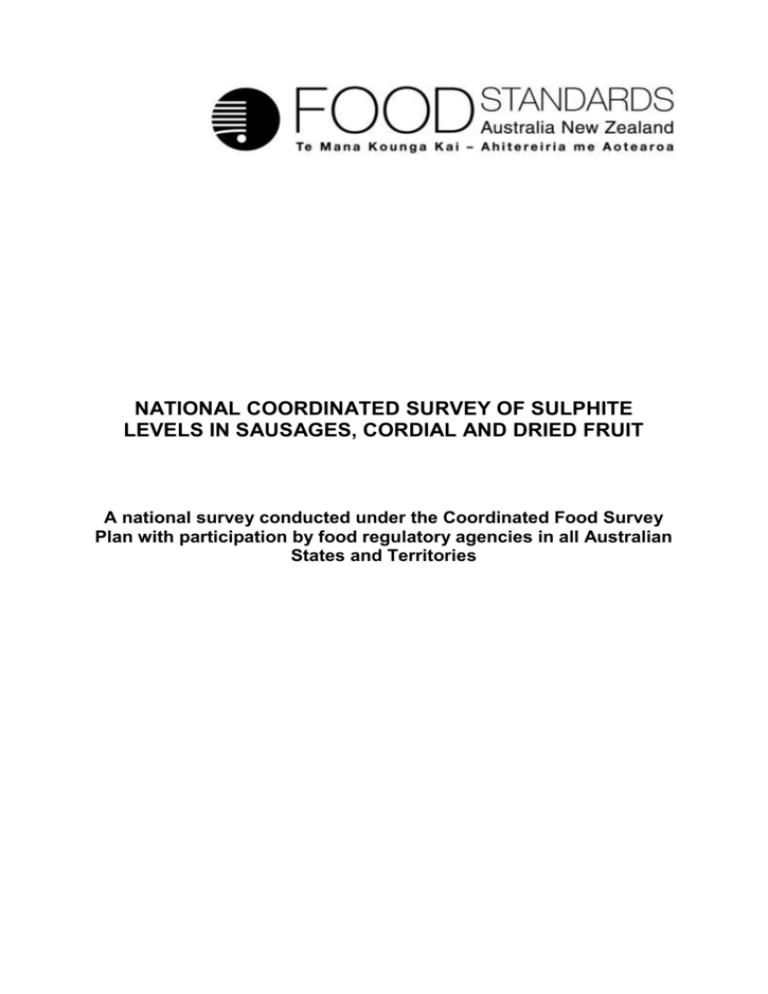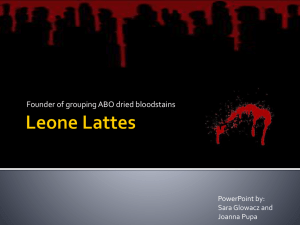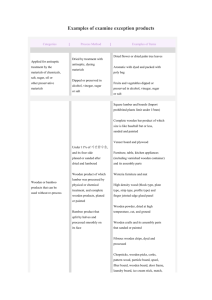Survey of Sulphite Levels in Sausages, Cordial and Dried Fruit
advertisement

NATIONAL COORDINATED SURVEY OF SULPHITE LEVELS IN SAUSAGES, CORDIAL AND DRIED FRUIT A national survey conducted under the Coordinated Food Survey Plan with participation by food regulatory agencies in all Australian States and Territories Summary Sulphites are food additives that are permitted in certain foods and beverages at levels specified in the Australia New Zealand Food Standards Code (the Code). Sulphites are used by the food industry to enhance the quality, appearance and extend the shelf life of foods and beverages such as sausages, cordial and dried fruit. In 2003, FSANZ estimated the dietary exposure of the Australian population to sulphites as part of the 21st Australian Total Diet Study (ATDS). The results found that some groups in the Australian population, particularly children, exceeded the acceptable daily intake (ADI) for sulphites. The major foods that contributed to sulphite exposure for children were beef sausages, cordial and dried apricots. Additional information on sulphite levels in dried apricots and apricot-containing products were collected in an analytical survey conducted by FSANZ in 2008. The findings indicated that sulphite levels in dried apricots were lower than determined in the 21st ATDS. To update and enhance the evidence base for the remaining foods, sausages, cordial and other dried fruit, FSANZ commissioned another analytical survey. These data will be incorporated into the dietary exposure assessment that will be undertaken for Proposal P298 – Benzoates and Sulphites Permissions in Food. This survey analysed a total of 207 individual samples, including 156 sausage samples, 30 cordial samples, 9 dried apple samples and 12 sultana samples. These samples were collected from butcher shops, poultry shops and supermarkets from around Australia and prepared in a ready to eat state before sulphite analysis. The key findings from this survey are: The majority of sulphite levels detected in sausage, cordial, dried apple and sultana samples were below the maximum permitted levels (MPLs) in the Code. On average, cooked plain thin beef sausages had higher levels of sulphites than pork, lamb, and chicken sausages (plain and flavoured), as well as plain thick beef sausages. The overall average of sulphites levels in sausages were similar to those reported in the 21st ATDS, however the current study analysed a larger sample number than the 21st ATDS. The levels in beef sausages (plain thick, plain thin and flavoured) are similar to those reported for the 21st ATDS. All levels of sulphites in cordial samples were well below the MPL. Regular cordial varieties had higher levels of sulphites than the diet/light/no added sugar and concentrated cordial varieties (on average). When compared to the results of the 21st ATDS, the mean level of sulphites in prepared regular cordial drinks was higher. Levels of sulphites in dried apple were substantially higher than sultanas. Sulphite levels in dried apple are higher overall than levels determined in the 21st ATDS, although they are still well below the MPL. The levels of sulphites in sultanas are generally lower than determined in the 21st ATDS and are considerably below the MPL. Page 2 of 19 This report presents the analytical results for the survey of sulphite levels in sausages, cordial and dried fruit. Dietary exposure assessments and comparisons to the relevant reference health standard have not been considered in this report but will be conducted as part of Proposal P298. Further information on P298 is available on the FSANZ website at http://www.foodstandards.gov.au/foodstandards/proposals/proposalp298benzoate2973.cfm . Acknowledgements FSANZ would like to thank the following organisations and people: State and Territory jurisdictions for their assistance with survey planning and sample collection. The staff at Symbio Alliance for the transportation, preparation and the analysis of sulphite levels in sausage, cordial and dried fruit samples. Page 3 of 19 TABLE OF CONTENTS Summary .............................................................................................................................. 2 Acknowledgements ............................................................................................................... 3 Abbreviations ........................................................................................................................ 5 Background........................................................................................................................... 6 Objective ............................................................................................................................... 7 Survey design and methodology ........................................................................................... 7 Results .................................................................................................................................. 9 Discussion .......................................................................................................................... 12 Conclusion .......................................................................................................................... 15 References ......................................................................................................................... 16 Appendix 1 Definitions and glossary of terms ...................................................................... 17 Appendix 2 Mean concentration of sulphites in sausages, cordial and dried fruit ................ 18 LIST OF TABLES Table 1: Number of samples analysed by food type .............................................................. 8 LIST OF FIGURES Figure 1: Range and mean SO2 levels by sausage type ..................................................... 10 Figure 2: Range and mean SO2 levels by cordial type ........................................................ 11 Page 4 of 19 Abbreviations ADI Acceptable Daily Intake ATDS Australian Total Diet Study FRSC Food Regulation Standing Committee FSANZ Food Standards Australia New Zealand ISC Implementation Sub-Committee LOD Limit of Detection LOQ Limit of Quantification LOR Limit of Reporting mg/kg Milligrams per kilogram MPL Maximum permitted level in the Australia New Zealand Food Standards Code (the Code) The Code The Australia New Zealand Food Standards Code Note: A glossary of terms can be found in Appendix 1 Page 5 of 19 Background Sulphites are widely used by the food industry as food additives to preserve foodstuffs (Cressey and Jones 2009). They have antioxidant and antimicrobial properties which prolong shelf life and enhance food quality and appearance. Sulphites are also used to prevent the discolouration of foods by inhibiting enzymatic and Maillard type browning reactions (Vandevijvere et al. 2010). Sulphites can also occur naturally in food at low levels, particularly fermented food, are naturally present in the body, and are also produced by some microorganisms (WHO 1987; Ough and Were 2005; Leclercq et al. 2009). A variety of forms of sulphites can be present in food. Many of these forms are highly reactive with other compounds such as aldehydes, ketones, reducing sugars and protein (Leclercq et al. 2009). In food, sulphites can be considered as free or bound, however some bound sulphites are reversible. For example, under specific conditions, reversibly bound sulphites can be released producing free sulphite into food. The free sulphite is promptly converted to sulphur dioxide (SO2) under acidic conditions (Ough and Were 2005; Leclercq et al. 2009). This seamless conversion is advantageous for analytical determinations of sulphite levels in food. While there are technological benefits to adding sulphites in foods, human sulphite consumption has been linked with allergy-like symptoms and asthmatic reactions in those who are sensitive to sulphites (FSANZ 2005). Standard 1.2.4 of the Australia New Zealand Food Standards Code (the Code) requires that the addition of sulphites to foods must be declared on the label in the ingredients list. This requirement informs consumers about the contents of the product, allowing an informed decision to be made about whether these sulphite-containing products should be avoided. Previous studies determining sulphites levels in foods The 21st Australian Total Diet Study (ATDS) coordinated by FSANZ in 2003, analysed concentrations of sulphites in selected foods and beverages. It also estimated the dietary exposure of the Australian population to sulphites (FSANZ 2005). The analytical results indicated that dried apricots (2097 mg/kg1), dried apple (1252 mg/kg1) and beef sausages (275 mg/kg1) had the highest sulphite levels when compared to 51 other foods and beverages. The dietary exposure assessment suggested that some population groups exceeded the relevant reference health standard for sulphites. The estimated dietary exposures were highest for young children as they have higher food consumption per kilogram of body weight and therefore greater exposures as a percentage of the ADI. For children (aged 2-5 and 6-12 years), the major foods that contributed to sulphite exposure were identified as beef sausages, cordial and dried apricots. Following the release of the 21st ATDS, FSANZ raised a proposal P298-Sulphates and Benzoates, to further examine the use of these two preservatives. In 2008, 120 additional samples of dried apricots and apricot-containing products, one of the major contributors to children’s sulphite exposure, were tested (FSANZ 2008). The survey concluded that mean sulphite levels in dried apricots were approximately 25% lower than the levels reported for the 21st ATDS. This information provided additional data on the level of sulphites in dried apricots. 1 Mean results (lower bound) from the 21st Australian Total Diet Study (ATDS) (FSANZ, 2005). Page 6 of 19 To gather current and more extensive data on sulphite usage in a variety of sausages, cordials and dried fruits, in comparison to the 21st ATDS, a further targeted survey has been conducted. This has focussed on sulphite levels in those remaining foods identified in the 21st ATDS as major contributors to children’s sulphites dietary exposure (sausages and cordial), as well as other types of dried fruit. Maximum permitted levels (MPLs) for sulphites in the Code The Maximum Permitted Levels (MPLs) for sulphites (including sulphur dioxide, bisulphites, and metabisulphites) in foods is specified in Standard 1.3.1. This includes a maximum of: 500 mg/kg in sausage and sausage meat containing raw unprocessed meat 115 mg/kg in water based flavoured drinks 3000 mg/kg in dried fruits and vegetables. The issue of specific populations, namely children, consuming high levels of sulphite containing foods, is being addressed by reviewing the current permissions for sulphites in the Code, through Proposal P298 - Benzoates and Sulphites Permissions in Food. Food prepared to a table ready state provides the most realistic estimate of dietary exposure and is consistent with total diet study methodology. Objective The objective of this survey is to determine the analytical concentration of sulphites in sausages, cordial and dried fruit (dried apple and sultanas) as consumed and then use these data in a dietary exposure estimate(see P298). This survey was undertaken as part of the Food Regulation Standing Committee’s (FRSC) Implementation Sub-Committee’s (ISC) Coordinated Food Survey Plan. The aim of the plan is to identify efficiencies and foster collaboration in the planning, implementation, coordination and consistent management of food surveys across jurisdictions in Australia and New Zealand. Survey design and methodology This survey was conducted between April and June 2011. A total of 207 samples were purchased, comprising 156 sausage samples, 30 cordial samples, 9 dried apple samples and 12 sultana samples (Table 1). Market share information was used to determine the amounts, brands and types of samples that were collected. The selection of sausage types was based on sales information from industry and the selection of cordial and dried fruit samples was weighted towards brands with a large market share. To take into account the variation of sulphite usage in the food industry, sausage samples were purchased from supermarkets, butchers and poultry shops in each state and territory in Australia. Thick and thin beef varieties were included, as well as lamb, chicken, pork, and other mixed meat and flavoured varieties. In order to give a representative sample, different brands and use by/best before dates were selected. Sausages that were excluded from the survey included those labelled or sold as sulphite/preservative free; organic; vegetarian; salami; chorizo; chipolatas; frankfurts; smoked; cured; liver; and parboiled or blood sausages. As dried fruit and cordial samples are generally manufactured locally and distributed nationally, samples were collected from supermarkets in the Australian Capital Territory Page 7 of 19 (ACT) during the same period. Different brands and use by/best before dates were selected to give a representative sample. For cordial samples, an assortment of flavours was purchased, as well as regular, concentrated and light/diet/no added sugar varieties. Alcoholic cordials such as liqueurs were excluded from this survey. Table 1: Number of samples analysed by food type Food type Number of samples Sausages Beef plain thin Beef plain thick Beef with flavouring^ Lamb with flavouring^# Pork plain Pork with flavouring^ Chicken plain Chicken with flavouring^ Kangaroo plain Mixed meat* 62 14 18 10 12 2 12 7 1 18 Subtotal 156 Subtotal 21 3 6 30 Cordial Regular Concentrated Diet/light/no added sugar Dried Fruit 9 12 Dried Apple Sultanas Subtotal 21 Total 207 ^Flavoured varieties included sausages with added herbs, spices and flavours (e.g. honey, mint, rosemary, red wine, garlic, spinach, pine nut, fetta, etc). #Only flavoured lamb sausages were sampled. *Mixed meat varieties included sausages with more than one type of meat (e.g. pork and veal). FSANZ engaged Symbio Alliance for the provision of analytical services for this survey. Symbio Alliance prepared all samples in a ready to eat state before analysis as this provides the most realistic estimate of dietary exposure. For example, sausages were dry fried and cordial was reconstituted according to the manufacturer’s instructions. For dried fruit, no sample preparation was required. Each sample was analysed individually to measure the level of sulphur dioxide, as a surrogate for sulphites present in food. This is in accordance with Standard 1.3.1 of the Code, where sulphur dioxide (SO2) is used to calculate the level of sulphites including bisulphites and metabisulphites in food. It is also one of the most commonly used sulphiting agents in food (Suh et al. 2007). Analytical concentrations were compared to the relevant MPL in the Code which refers to food as sold or prepared in accordance with directions. While this comparison was made, this survey was not undertaken for compliance purposes, but to gather data to incorporate into a dietary exposure estimate (see P298). Page 8 of 19 Symbio Alliance used an in-house method (CF027), accredited by the National Association of Testing Authorities (NATA), based on AOAC 990.28. This method used a distillation step followed by titration, reporting the result as SO2, in line with the Code. The Limit of Detection (LOD) and Limit of Reporting (LOR) were 5 mg/kg, and the Limit of Quantification (LOQ) was 25 mg/kg. For results reported between the LOD and LOQ, there is a higher degree of uncertainty. The level of uncertainty decreases for levels reported at or above the LOQ. Given sulphite permissions in the Code for sausages, cordial and dried fruit are at least 5fold higher than the LOQ, it was likely that the sulphite levels detected in the samples would be well above the LOQ. Given sulphites are chemically unstable and may evaporate from foods and beverages as sulphur dioxide gas (UKFSA, 2004) this limitation should be noted in this survey. As concentrations of sulphites were not analysed in a single sample over time, it is not possible to determine any losses during the opening of food packaging or the preparation and storage of samples. Results A total of 207 individual samples were analysed for sulphites (measured as sulphur dioxide, SO2). Given that sulphites are preservatives that are intentionally added to sausages, cordial and dried fruit, for results reported as less than the LOR of 5mg/kg, it was assumed that no sulphites were present in the food or beverage and therefore a zero value was assigned. A summary of results, including mean values where LOR=0 (lower bound value) and LOR=5 mg/kg (upper bound value), is provided at Appendix 2. Sausages The mean sulphur dioxide levels for all sausage types were well below the MPL of 500 mg/kg (Figure 1). Mean values ranged from 163 mg/kg (chicken with flavouring) to 317 mg/kg (beef plain thin). When combining all beef sausage types (plain thin, plain thick and flavoured) the mean was 294 mg/kg. The highest sulphur dioxide level detected was 855 mg/kg in a beef plain thin sausage sample. This is above the MPL of 500 mg/kg. There were only two other sausage samples with reported levels above the MPL, both beef plain thin samples with sulphur dioxide concentrations of 528 mg/kg and 610 mg/kg, respectively. The relevant state or territory jurisdiction was notified of these results for their consideration and appropriate action. The lowest sulphur dioxide level detected was 32 mg/kg in a flavoured beef sausage. The only sausage sample with a sulphur dioxide level below the LOR of 5 mg/kg was a chicken sausage with flavouring. As the kangaroo plain sausage type only included one sample, the mean sulphur dioxide level could not be calculated. The individual result for this sample was 162 mg/kg, which is well below the MPL. In general, sulphur dioxide levels were most variable in the beef plain thin sausage type, with levels ranging between 100 mg/kg-855 mg/kg. In contrast, the least variable results were found in pork sausages (with flavouring), with levels ranging between 256 mg/kg-296 mg/kg. Overall, the differences in the ranges between different sausage types may simply reflect the variable usage of sulphites in the manufacturing of sausages. Page 9 of 19 Figure 1: The range and mean SO2 levels in various sausage types MPL # ^ Thin sausage samples without the specific meat type labelled on the product were included in the beef plain thin category. * Includes flavours such as added honey, herbs (e.g. mint, rosemary, thyme, parsley, fennel, and chives), red wine, pepper, garlic, tomato and onion, Mexican, salsa, spinach and pine nut, sundried tomato, fetta, leek, apple and cider, lime, and lemongrass and cheese varieties. Flavoured sausages without the specific meat labelled on the product were included in the beef with flavouring category. #Includes beef and lamb, beef and pork, duck and kangaroo/wallaby, beef and mutton, as well as pork and veal varieties. Please note only one kangaroo plain sample was analysed (with a concentration of 162 mg/kg) and has not been included in Figure 1. Cordial The sulphur dioxide levels for all individual cordial samples in a ready to drink state were well below the MPL of 115 mg/kg (Figure 2). The highest sulphur dioxide level detected was 38 mg/kg in a regular raspberry cordial sample. The lowest level reported was 6 mg/kg for a lemon diet/light/no added sugar cordial sample. There were a total of six cordial samples with results below the LOR of 5 mg/kg; two regular samples (bubble gum and apple/blackcurrant), two diet/light/no added sugar samples (lime and an apple raspberry) and two concentrated samples (cola and orange). The mean level of sulphur dioxide for the regular cordial was the highest at 21 mg/kg, followed by the diet/light/no added sugar cordial at 12 mg/kg and the concentrated type at 3 mg/kg. Sulphur dioxide levels in the regular type of cordial included the most variation, with levels ranging from below the LOR of 5 mg/kg to 38 mg/kg. This was followed by the diet/light/no added sugar and concentrated types at <5 mg/kg-32 mg/kg and <5 mg/kg-10 mg/kg, respectively. Page 10 of 19 Figure 2: The range and mean of SO2 levels in various cordial types *Included flavours such as lime, raspberry, orange, pineapple, mango, mixed fruit, bubble gum, creaming soda, cola, lemon, apple and blackcurrant varieties. Dried Fruit All sulphur dioxide levels detected in individual dried apple and sultana samples were well below the MPL of 3000 mg/kg (Figure 3 and 4). There was a considerable difference between the mean level of sulphur dioxide for dried apple at 1334 mg/kg and the mean for sultana samples at 2 mg/kg. Dried apple samples demonstrated the most variability of SO2 levels, ranging from 522 mg/kg-2060 mg/kg (Figure 3). The range of sulphur dioxide levels for sultana samples was substantially lower at <5 mg/kg-8 mg/kg (Figure 4). In total, there were nine sultana samples that were below the LOR of 5 mg/kg, which is approximately 75% of the sultana samples analysed. Page 11 of 19 Figure 3: Individual SO2 levels in various dried apple samples analysed. Level of sulphur dioxide (SO2) (mg/kg) 3500 3000 MPL = 3000 mg/kg 2500 2000 1500 1000 500 0 0 1 2 3 4 5 6 7 8 9 10 Dried Apple Sample No. The red line indicated the MPL of 3000 mg/kg for dried fruits as indicated in the Code. Figure 4: Individual SO2 levels in various dried sultana samples analysed. Level of sulphur dioxide (SO2) (mg/kg) 10 MPL = 3000 mg/kg 9 8 7 6 5 4 3 2 1 0 0 1 2 3 4 5 6 7 8 9 10 11 12 Dried Sultana Sample No. Sultana samples with an SO concentration equivalent to the LOR of 5 mg/kg, have been graphed at the LOR. 2 Discussion Sausages Sulphites are added to raw sausages to preserve meat quality and appearance (Ough and Were 2005). They help maintain the pink colour of sausage meat which otherwise would turn grey, and prolong the shelf life by controlling microbial spoilage (Ough and Were 2005). The Code specifies the MPL of 500 mg/kg of sulphites in sausage and sausage meat containing raw unprocessed meat. In this survey, sulphite levels (as measured by sulphur dioxide) in all sausages were below the MPL with the exception of three plain thin beef Page 12 of 19 sausage samples. This accounted for 5% of all plain thin beef sausages analysed and 2% of all sausage samples in total. In line with the majority of sausage samples, the mean values for all sausage meats were also below the MPL for sulphites. Although the survey was not designed for compliance purposes, the three samples that exceeded the MPL for sulphites were referred to the relevant state or territory jurisdiction for their consideration and appropriate action. The sausage meat with the highest mean and largest range of sulphur dioxide levels across the category was the plain thin beef sausage (n=62). This category also included any thin sausages that did not specify the meat type on the packaging as they were assumed to be beef. This variation in SO2 results may simply reflect the variable use of sulphites in this industry. The survey results were reported for cooked sausages, however the MPL applies to the food as sold. In the case of fried sausages, previous studies have shown that the sulphite levels are similar in sausages cooked for 10 minutes and uncooked sausages. This is because the relative loss of sulphites is similar to the relative loss of sausage weight on cooking (Jordan et al 2006). Furthermore, Board and Banks (1982) have demonstrated that the level of total sulphites in sausages decreases over time and is influenced by storage conditions. Given the sausage samples for this survey were collected from all states and territories in Australia, storage conditions during sample collection and transportation may have influenced the rate of SO2 loss in the sample. Comparisons with other studies The levels of sulphites found in sausages in this survey are similar to those reported for the 21st ATDS (FSANZ 2005). For example, the mean for all sausages in this survey (n=156) was 275 mg/kg which is similar to the mean for beef sausages sampled in the 21st ATDS (n=15). When comparing the mean sulphite concentration of beef sausages in the 21st ATDS to the mean concentration of beef sausages in this survey (plain thin, plain thick and flavoured), the levels are slightly higher (from 275 mg/kg to 294 mg/kg, respectively). This difference is considered to be minimal. Given the similarity in results, these findings support the sample methodology used in the ATDS and give an indication how representative these sampling procedures are. In contrast, a study conducted in New Zealand found much lower sulphite levels in beef sausages (mean, 179 mg/kg; range, <25 mg/kg–429 mg/kg) (Cressey and Jones 2009). However, these lower levels may be due to differences in the types and number (n=10) of sausages sampled, and the fact that sulphite-free sausages were also sampled. Also, a variation could be attributed to differences in sulphite content between Australia and New Zealand due to differences in climate, the handling of raw materials and the length of the supply chain. Cordial Sulphites are added to cordial to preserve its quality and appearance over a prolonged period of time (Ough and Were 2005). In Australia and New Zealand, the MPL for sulphites in water based flavoured drinks is 115 mg/kg. In this survey, the sulphite levels detected in cordial samples were all below the MPL, with the highest level at 38 mg/kg. On average, the sulphite levels for regular cordial samples were higher and more variable than the other types of cordial. Page 13 of 19 It should be noted that the concentrated cordial samples did not include a higher level of sulphites than the other non-concentrated types. On the contrary, concentrated samples had the lowest levels of sulphites (n=3), including two results below the LOR of 5 mg/kg. Comparison with other studies In comparison to the 21st ATDS (FSANZ 2005), this survey detected higher levels of sulphites in made-up (diluted) cordial. The mean level for regular cordial is higher in the current study (21 mg/kg) compared to the 21stATDS (10 mg/kg). Sulphite levels are also higher when regular cordial samples in the 21st ATDS at 10mg/kg are compared to all cordial samples in this survey (regular, concentrated and light/diet/no added sugar combined) at 18 mg/kg. However, despite these higher levels, the levels for all cordial samples are still well below the MPL of 115 mg/kg permitted in the Code. This finding is consistent with those reported in a New Zealand study where mean sulphite levels in regular cordial were approximately 14 mg/L at the mean (Cressey and Jones 2009). Also, the range of results for regular cordial was similar to this survey, ranging from <10 mg/kg-37 mg/kg compared to <5 mg/kg-38 mg/kg, respectively. As sulphites are chemically unstable, they can evaporate as sulphur dioxide gas once the packaging is opened (UKFSA 2004). Sulphite levels may also reduce during storage, especially when the packaging is frequently reopened (UKFSA 2004) as is expected for cordial. Dried Fruit Preventing discolouration (browning and spotting) is one of the main functions of sulphite use in dried fruit (Ough and Were 2005). In this survey, all sulphite levels detected in dried apple and sultana samples were well below the MPL of 3000 mg/kg, with the highest level in a dried apple sample at 2060 mg/kg and a mean sulphur dioxide concentration of 1334 mg/kg. There was a considerable difference between the levels of sulphites for dried apple compared to sultana samples. Sultanas had particularly low levels of sulphites, with approximately 75% of results below the LOR of 5 mg/kg. Comparisons with other studies In comparison with the 21st ATDS, the sulphite levels in the current study in sultanas are lower, from 74 mg/kg down to 2 mg/kg at the mean. These lower levels are also evident with the maximum levels detected from 350 mg/kg in the 21st ATDS to 8 mg/kg in the current study. In addition, a New Zealand study reported no detections of sulphites in sultanas (Cressey and Jones 2009). For dried apple, mean sulphur dioxide levels are similar to the 21st ATDS with values of 1252 mg/kg to 1334 mg/kg, in this current study. However, sulphite levels in all dried apple samples are still approximately less than half the MPL of 3000 mg/kg. When compared to other dried fruit samples such as apricots, the level of sulphites is lower in dried apple and sultanas (FSANZ 2008). In 2008, dried apricots and apricot containing products were analysed for sulphur dioxide in a survey conducted by FSANZ (FSANZ 2008). The mean sulphite level for dried apricots in the 2008 survey was 1554 mg/kg, which is higher than the dried apple and substantially higher than the sultana samples analysed in this survey at 1334 mg/kg and 2 mg/kg, respectively. However, it should also be noted that levels of sulphites in dried apricots are still well below the MPL of 3000 mg/kg. Also, dried apricot levels are lower by approximately 25% (from 2097 mg/kg to 1554 mg/kg) in Page 14 of 19 comparison with the 21st ATDS in 2003 (FSANZ 2005). This lower level more closely resembles the findings of a New Zealand study, which detected a mean sulphite concentration of 1554 mg/kg in dried apricots (Cressey and Jones 2009). Conclusion Overall, the results of this survey indicate that the majority of sausage, cordial and dried fruit samples were below the relevant MPLs in the Code. In comparison with the 21st ATDS conducted in 2003, the levels of sulphites in sausages are similar. There are some differences in the levels of sulphites in cordial and similar sulphite levels in dried apple; however, all levels are still well below the regulatory limit in Australia. Notably, the concentrations of sulphites levels are lower in sultanas and apricots compared to those reported in the 21st ATDS (FSANZ 2008) This survey has further contributed to the evidence base on the levels of sulphites in sausages, cordial and dried fruit. This survey has tested more sausages, cordial and dried fruit samples relative to the 21st ATDS. These new data will be used in the dietary exposure assessments for Proposal P298 - Benzoates and Sulphites Permissions in Food. For further information on P298, please refer to the FSANZ website. Page 15 of 19 References Banks JG, Board RG (1982) Comparison of methods for the determination of free and bound sulphur dioxide in stored British fresh sausages. Journal of the Science of Food and Agriculture 33: 197-203 Cressey P, Jones S (2009) Levels of preservatives (sulphite, sorbate and benzoate) in New Zealand foods and estimated dietary exposure. Food Additives and Contaminants 26: 604613 FSANZ (2005) The 21st Australian Total Diet Study (ATDS): A total diet study of sulphites, benzoates and sorbates. Food Standards Australia New Zealand, Canberra. http://www.foodstandards.gov.au/_srcfiles/21st%20ATD%20Study%20report-Aug051.pdf. Accessed 1 April 2011 FSANZ (2008) Food Surveillance News Spring 2008: Survey shows levels of sulphites in dried apricots have decreased since 2003. Food Standards Australia New Zealand, Canberra http://www.foodstandards.gov.au/scienceandeducation/monitoringandsurveillance/foodsurvei llancenewsletter/spring2008.cfm. Accessed 11 July 2011 Jordan M, Spragg A, Savin S, Theodosis D, Tsotsou A (2006) Fate of sulphites during the cooking and storage of prepared foods, FSA Project A01045, United Kingdom Food Standards Agency, London Ough CS, Were L (2005) Sulfur dioxide and sulfites. Ch 5 In: Davidson PM, Sofos JN, Branen AL (eds) Antimicrobials in food. 3rd ed, Taylor & Francis Group, Boca Raton, p. 143167 Leclercq C, Le Donne C, Toledo MCF (2009) Sulfites: Assessment of dietary exposure. In WHO Food Additives Series Safety evaluation of certain food additives, WHO Press, Switzerland, p221-259 Suh H, Cho Y, Chung M, Kim BH (2007) Preliminary data on sulphite intake from the Korean diet. Journal of Food Composition and Analysis 20:212-219 UKFSA (2004) Survey of sulphur dioxide in soft drinks. United Kingdom Food Standards Agency, London http://www.food.gov.uk/multimedia/pdfs/fsis5404.pdf. Accessed 11 July 2011 Vandevijvere S, Temme E, Andjelkovic M, De Wil M, Vinkx C, Goeyens L, Van Loco J (2010) Estimate of intake of sulfites in the Belgian adult population. Food Additives and Contaminants 27(8): 1072-1083 WHO (1987) WHO Food Additive Series 21. http://www.inchem.org/documents/jecfa/jecmono/v21je15.htm 621. Accessed on 28 October 2011 WHO (2009) Environmental Health Criteria 240 Principles and Methods for the Risk Assessment of Chemicals in Food – Annex 1 Glossary of Terms. World Health Organization. Geneva. Page 16 of 19 APPENDICES Appendix 1 Definitions and glossary of terms ADI The ADI is an estimate of the amount of a substance in food or drinking water, which can be ingested daily over a lifetime without appreciable risk to health. The ADI is expressed on a body weight basis (WHO 2009). Food Regulation Standing Committee (FRSC) FRSC is responsible for the coordination and provision of policy advice to the Australia and New Zealand Food Regulation Ministerial Council in relation to food regulation. Implementation Sub-Committee (ISC) ISC is a sub-committee of FRSC and is responsible for overseeing a consistent approach to the implementation and enforcement of food regulations and standards across jurisdictions. Limit of Detection (LOD) The LOD is the lowest concentration of a chemical that can be qualitatively detected using a specified laboratory method and/or item of laboratory equipment (i.e. its presence can be detected but not quantified). Limit of Quantification (LOQ) The LOQ is the lowest concentration of a chemical that can be detected and quantified, with an acceptable degree of certainty, using a specified laboratory method and/or item of laboratory equipment. Limit of Reporting (LOR) The LOR is the lowest concentration level that the laboratory reports analytical results. For the purposes of this report, the LOD was chosen as the basis for the LOR (i.e. the LOR is equivalent to the LOD). Maximum Permitted Level (MPL) The maximum level of an additive permitted in a food or beverage as specified in the Australia New Zealand Food Standards Code (the Code) Page 17 of 19 Appendix 2 Mean concentration of sulphites in sausages, cordial and dried fruit Table A1: Mean concentrations of sulphites in sausages (mg/kg) Sausage type No. of analyses No. of samples <LOR Mean (LOR=0) Mean (LOR=5) Minimum Maximum Beef, plain thin 62 0 317 317 100 855 Beef, plain thick 14 0 262 262 117 466 Beef with flavouring 18 0 243 243 32 373 Lamb with flavouring 10 0 264 264 177 369 Pork, plain 12 0 240 240 54 395 Pork with flavouring 2 0 276 276 256 296 Chicken, plain 11 0 238 238 79 369 Chicken with flavouring 7 1 163 163 0 301 Kangaroo, plain 1 0 162 162 162 162 Mixed meat 18 0 277 277 70 494 Notes to table: 1. Results are derived from individual samples. 2. The limit of reporting (LOR) is 5 mg/kg. 3. Two means are provided in the table; one derived assuming results <LOR are assigned a value of zero and the other derived assuming results <LOR are assigned a value of 5 mg/kg (LOR). 4. All results have been rounded to the nearest whole number. Table A2: Mean concentrations of sulphites in cordial (mg/kg) Cordial type No. of analyses No. of samples <LOR Mean (LOR=0) Mean (LOR=5) Minimum Maximum Cordial, regular 21 2 21 22 0 38 Cordial, diet (light) 6 2 12 14 0 32 Cordial, concentrate 3 2 3 7 0 10 Notes to table: 1. Results are derived from individual samples. 2. The limit of reporting (LOR) is 5 mg/kg. 3. Two means are provided in the table; one derived assuming results <LOR are assigned a value of zero and the other derived assuming results <LOR are assigned a value of 5 mg/kg (LOR). 4. All results have been rounded to the nearest whole number. Page 18 of 19 Table A3: Mean concentrations of sulphites in dried fruit (mg/kg) Dried fruit type No. of analyses No. of samples <LOR Mean (LOR=0) Mean (LOR=5) Minimum Maximum Dried apple 9 0 1334 1334 522 2060 Dried sultanas 12 9 2 5 0 8 Notes to table: 1. Results are derived from individual samples. 2. The limit of reporting (LOR) is 5 mg/kg. 3. Two means are provided in the table; one derived assuming results <LOR are assigned a value of zero and the other derived assuming results <LOR are assigned a value of 5 mg/kg (LOR). 4. All results have been rounded to the nearest whole number. Page 19 of 19







